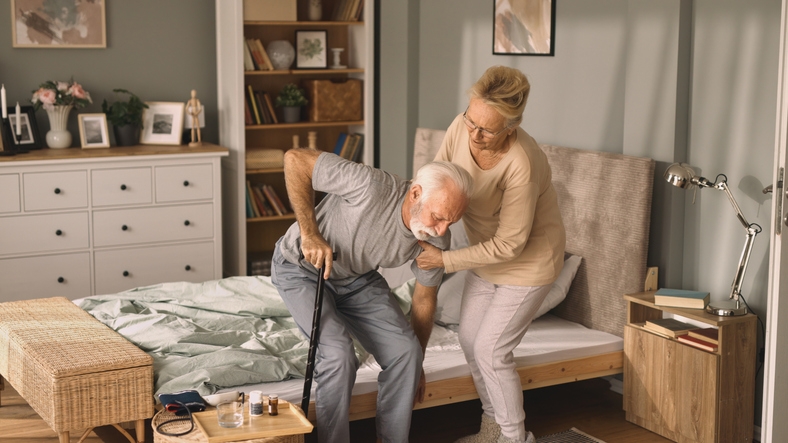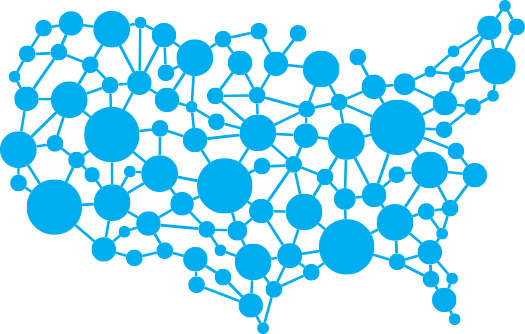Recover at Home After a Stroke: What Families Need to Know

May is Stroke Awareness Month, and while there’s plenty of attention on signs and prevention (as there should be), there’s another conversation that deserves just as much space: what happens after a stroke?
The truth is, the hospital stay is just the beginning. Recovery doesn’t stop at discharge—it continues at home, where routines resume, challenges surface, and the real healing happens. And for families, that can feel both hopeful and overwhelming.
At Your Side Home Care provides transitional care that bridges the gap between hospital and home, offering hands-on support and thoughtful guidance through every stage of recovery. Whether helping with mobility, managing medications, or simply offering encouragement, our caregivers are trained to meet the unique needs of stroke survivors and the loved ones caring for them.
Homecoming After a Stroke: Relief, Then Reality
Bringing a loved one home after a stroke often comes with a sense of relief. You’re thankful they’re stable enough to be discharged, but as soon as you’re through the front door, the questions start flooding in:
- Can they safely get to the bathroom?
- What about medications?
- Do they remember how to do everyday tasks?
- What if they fall again?
The transition from hospital to home isn’t always smooth. While stroke survivors leave the hospital in a stable condition, they often need substantial help in regaining independence, managing medical care, and adjusting to changes in their health.
What Can a Stroke Affect?
Stroke recovery can affect speech, movement, memory, and even personality. Some individuals may struggle with basic tasks like walking, eating, or managing emotions. Others may experience cognitive or memory challenges, such as difficulty concentrating or remembering things they did just hours before. The effects often depend on which side of the brain was impacted:
- Right-brain stroke: can cause left-side weakness, vision problems, quick/impulsive behavior, and memory loss related to performance.
- Left-brain stroke: may result in right-side weakness, speech and language difficulties, cautious behavior, and communication-related memory loss.
And while every stroke is different, one thing remains the same: recovery requires careful, continuous support.
Why Transitional Care Matters After a Stroke
Transitional care is designed to help individuals safely move from the hospital environment back into their homes, with the goal of reducing hospital readmissions, preventing health complications, and improving long-term recovery outcomes. This care is especially important for stroke survivors who may require extensive assistance with mobility, medications, therapy exercises, and day-to-day activities.
In-home care can also make a big difference in the long term.
Here’s the unfortunate reality: 1 in 4 stroke survivors will have another—but up to 80% of strokes are preventable. Caregivers can play a vital role in supporting lifestyle changes, ensuring medication adherence, providing transportation to follow-up appointments, and more.
Transitional Care at At Your Side Home Care
For us, transitional care is more than a service—it’s a bridge between hospital or rehab discharge and long-term recovery at home. Our goal is to accelerate discharge readiness, reduce the risk of hospital readmission, and provide peace of mind for both families and care teams.
We understand that the first 30 days after a stroke are critical. It’s during this window that survivors are at the highest risk of complications and setbacks. Our care model is built around that reality—offering rapid response, same-day staffing, and a personalized 30-day Transition of Care Program that supports every step of the journey.
What Our Transitional Care Includes
- Same-day start of care and transportation from the hospital or rehab to home
- Coordination with discharge teams to align on recovery goals and follow-up care
- Seven touchpoints in the first 30 days, ensuring close monitoring and proactive support
- Early intervention protocols to address concerns before they become complications
- Communication with physicians, therapists, and family caregivers to keep everyone aligned
- Fall risk mitigation, including home safety assessments and physical assistance
- Support for therapy carryover, integrating PT/OT routines into daily life
- Respite and education for families, helping reduce burnout and improve caregiver confidence
Every plan of care is tailored to the individual, reflecting their physical needs, emotional well-being, personal goals, and family dynamics. Whether your loved one is dealing with mobility limitations, cognitive changes, or simply needs help getting back into a routine, we’re here to help them regain independence safely.
We also collaborate with community partners—like hospice and home health—when additional clinical care is needed. Acting as an extension of the care team, our caregivers reinforce progress made in rehab and help families feel supported long after discharge.
Because while 90% of patients feel ready to come home, only 66% of family caregivers feel prepared to take on the responsibility. That’s where we come in—to help close the gap, support the recovery process, and keep your loved one where they feel safest: at home.
What Recovery Really Looks Like at Home
No two stroke recoveries are the same, but here are a few things we’ve seen make a major difference in the recovery process:
Daily Routine Support
When stroke survivors adjust to life at home, they often face physical and cognitive challenges that make completing everyday tasks difficult. Simple activities, like bathing, dressing, or even preparing meals, can feel insurmountable. Having a caregiver available to assist with these activities guarantees safety and helps the individual maintain their dignity and sense of independence.
Medication Management
Stroke survivors often need multiple medications to manage symptoms, prevent another stroke, or treat related conditions. Keeping track of medication schedules, dosages, and potential side effects can become confusing, especially when combined with the mental and physical fatigue that comes with recovery.
At Your Side caregivers are trained to help with medication reminders, ensuring that prescriptions are taken on time and as directed, preventing dangerous mix-ups and complications.
Fall Risk Management
In the early stages of recovery, falls are a major concern. Stroke survivors often have limited mobility, balance issues, or weakness on one side of the body, which increases the likelihood of falls. But even after the initial recovery phase, the risk of falls doesn’t go away.
Small things like rearranging furniture to create a safer path or providing assistance when moving around can help prevent accidents. Caregivers can also help with physical therapy exercises to rebuild strength, balance, and coordination, further reducing fall risks.
Emotional Support
It’s common for survivors to experience depression, anxiety, or frustration as they come to terms with their new reality. Family members can often be overwhelmed trying to manage emotional support alongside physical care. This is where having a trained caregiver on the team can be invaluable.
At Your Side caregivers not only provide hands-on assistance but also offer emotional support, helping stroke survivors navigate the ups and downs of recovery with encouragement and patience.
Encouraging Independence
One of the biggest challenges of stroke recovery is striking the right balance between offering help and encouraging independence. Stroke survivors often feel frustrated by their dependence on others, and that frustration can hinder their recovery.
At Your Side Home Care's caregivers are trained to foster independence where possible, providing support in ways that encourage a survivor to do what they can for themselves, which can significantly boost confidence and motivation.
How At Your Side Home Care Steps In
At Your Side Home Care understands that stroke recovery is a family journey, and our goal is to make that journey easier, less stressful, and more hopeful.
Whether you need help a few hours a day or a more hands-on care plan, our caregivers are trained to understand stroke recovery and how to meet your loved one where they are, both physically and emotionally.
Personal Care
We assist with daily activities like bathing, dressing, grooming, and toileting to help maintain dignity and comfort.
Exercise and Rehabilitation
We support at-home rehab routines by helping clients stay consistent with physical therapy and passive range-of-motion exercises.
Medication Reminders
Correct timing and dosage can be critical in preventing complications. Our caregivers help keep this on track.
Nutrition & Swallowing Support
Caregivers can help with meal preparation, ensuring a balanced and nutritious diet that supports recovery and addresses any swallowing difficulties. They can also monitor for choking hazards.
Companionship & Mental Engagement
Stroke survivors may experience isolation, depression, and anxiety. Home care provides social interaction and emotional support, reducing feelings of loneliness.
Caregivers can engage survivors in activities that help with memory, problem-solving, and communication, as directed by therapists. This might include memory games, conversation, and music.
Communication Support
For those with speech difficulties (aphasia), caregivers can practice communication strategies, use visual aids, and create a supportive environment for the survivor to express themselves. They can also remind them to perform speech therapy exercises.
Environmental Safety
We assess and modify the home environment to minimize fall risks—particularly for clients with one-sided weakness, spasticity, or vision issues.
Emergency Preparedness
We train caregivers to develop emergency plans and recognize stroke warning signs using the BE FAST acronym (Balance, Eyes, Face, Arms, Speech, Time) so they can always respond when necessary.
Liaison with Healthcare Team
Our caregivers keep families and medical teams informed, helping to report changes in condition, attend appointments, and align with the discharge plan. We also work closely with discharge planners, therapists, and physicians to guarantee a seamless transition from the hospital to home.
This coordinated approach helps reduce the chance of readmission, improves recovery outcomes, and makes sure your loved one’s care needs are met consistently.
Respite Care
We also provide short-term support so primary caregivers can rest, run errands, or recharge—because burnout is real, and your well-being matters too.
Let’s Talk About What’s Next
If your loved one is recovering from a stroke—or preparing to come home soon—let’s talk. We can help you put together a plan that works for your family, your routine, and your peace of mind. And because we’re part of your local community, you won’t be calling a stranger. You’ll be calling someone who gets it.
May is Stroke Awareness Month—take the opportunity to educate yourself and others. Understanding the risks, signs, and stages of recovery can make all the difference when minutes matter and healing begins.
Whether you’re searching for resources, need help navigating what post-stroke care should look like, or just want to talk through options with someone who’s done this before, we’re here. You don’t have to figure it all out on your own. Let’s make stroke recovery a little easier, together.
Find Transitional Care Support For Post-Stroke Recovery in Texas
At Your Side Home Care is here to make the transition a little less overwhelming. If your loved one is recovering from a stroke, our team can help with in-home support, personalized care plans, and guidance on what to expect next. From preventing readmissions to supporting daily routines, we’re committed to helping your family feel confident and cared for every step of the way.

